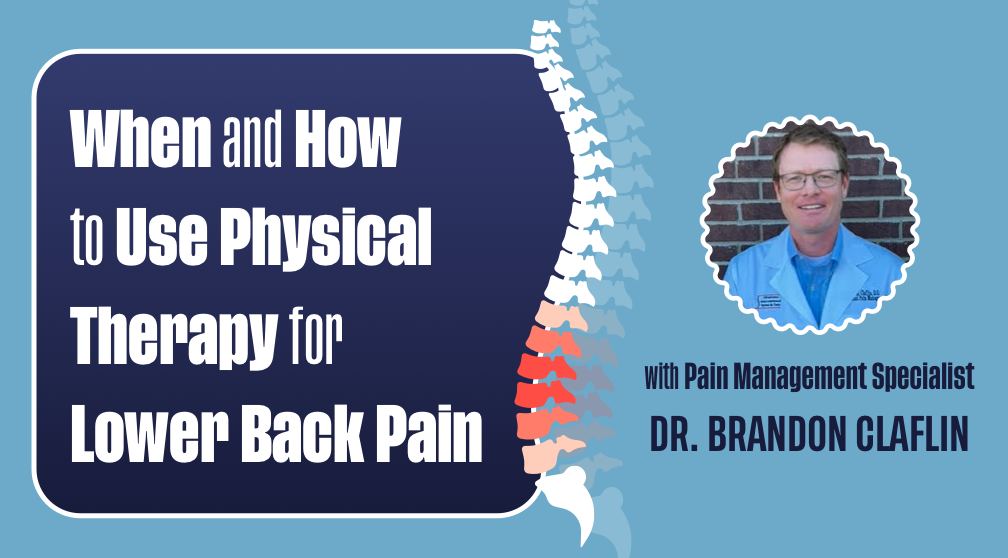Check your calendar. Has your low back pain lasted longer than a couple of weeks?
If so, it may be time for your doctor to refer you to a physical therapist. What is physical therapy (PT)? Why should physical therapy be used? What is involved? Are there any studies proving that physical therapy works?
We asked Pain Management Specialist, Dr. Brandon Claflin of Oklahoma, for the answers to these questions.
“Physical therapy is a number of different techniques such as massage, heat treatment, exercise, electrical stimulation, aquatic therapy, bikes, treadmills, and more that are used for the purpose of regaining functionality after an injury. Getting patients back to work is a primary goal, Dr. Brandon Claflin of Oklahoma shared.
“A secondary purpose of physical therapy is to reduce dependence on opioids, having advanced imaging services, and a visit to the ER,” he said.
Table of Contents
Studies Verify Dr. Brandon Claflin of Oklahoma’s Opinion of Using Physical Therapy
According to a University of Washington School of Medicine professor, Dr. Bianca Frogner, people in all 50 states of the U.S. have the right to seek some level of physical therapy care without a physician referral. However, some insurance companies will require additional payment for this type of pain treatment, causing patients not to opt for this type of treatment.
Dr. Frogner’s study revealed the following: that there was an 89 percent lower chance of receiving a prescription for opioids, a 28 percent lower chance of having advanced imaging services, and a 15 percent lower chance of an emergency room visit. All of these resulted from having physical therapy intervention early in their care. The study also showed that patients lowered their costs by spending less on outpatient and pharmacy expenses. Doing prescribed exercise is a more proven method of care.
Other studies, such as one published in the Physical Therapy & Rehabilitation Journal in 2018, show similar findings. This study of 46,914 patients reported that those receiving PT within three days consistently had the lowest healthcare utilization and costs. And a United Kingdom study recommended that having physical therapy within two to four weeks after a primary care physician should be the protocol.
When to Use Physical Therapy
“During the first visit with treatment for a patient, physical therapy may or may not be recommended. The exercises that are used help condition muscles, restore their strength, and regain the movement that has been lost,” Dr. Brandon Claflin of Oklahoma stated.
The types of exercises used may be a repetitive range of motion exercises, stabilization exercises, and manipulative/mobilization exercises. Repetitive range of motion exercises are used when there is a disc bulge or spinal stenosis that is putting pressure on a nerve.
For example, if the pain is worse when the patient bends forward, then repetitive exercises are chosen to bend backward. This exercise opens up the area where the nerve is compressed.
Stabilization exercises will help retrain the deep muscles of the spine. Often when there is back pain, the deep muscles are unable to stabilize the spine because they are too weak or not firing correctly. This makes the muscles on top of the deep muscles become too tense or tightly drawn, which contributes to additional pain and tightness.
Manipulation/mobilization exercises are short, rapid movements over a joint for the purpose of getting back the range of motion the joint is supposed to have.
A complete program of rehabilitation exercises, combined with other physical therapy methods, is created by a physical therapist or chiropractic physician. There are specific conditions where physical therapy will make a significant difference in the improvement of patients’ quality of life – and those where it won’t. However, when it comes to low back pain, you can usually expect significant improvement.
Some physical therapy programs may have upgraded the way they do their physical therapy by using telemedicine and other technologically innovative methods. These enhanced approaches to physical therapy may also offer a bit of fun for the patient suffering from low back pain.
When Does Dr. Brandon Claflin of Oklahoma Believe It’s Time to Get PT After Seeing Your Primary Doctor?
“When a course of physical therapy isn’t working, then it may be time to see a doctor. Patients usually come to see a pain management specialist after seeing their primary physician with unsatisfactory results,” Dr. Brandon Claflin in Oklahoma said.
“If a treatment does not work for a patient, there is a specific path of treatments to try. After a course of physical therapy or round of injections with no improvement in pain, it’s time to order further diagnostic tests or consult with other specialists. This allows us to regroup and reevaluate, so we can continue to move forward,” he also shared.
Summary
The time to use physical therapy is in the beginning of someone’s treatment plan for low back pain. This may occur before or after an appointment with a primary care physician. Physical therapy may include three types of exercises – repetitive motion, stabilization, and manipulation/mobilization, as well as heat, ultrasound, electrical therapies, and bikes/treadmills. Often a complete physical therapy rehabilitation program is created, and the results have been found to significantly improve the patient’s life while lowering health care costs.

